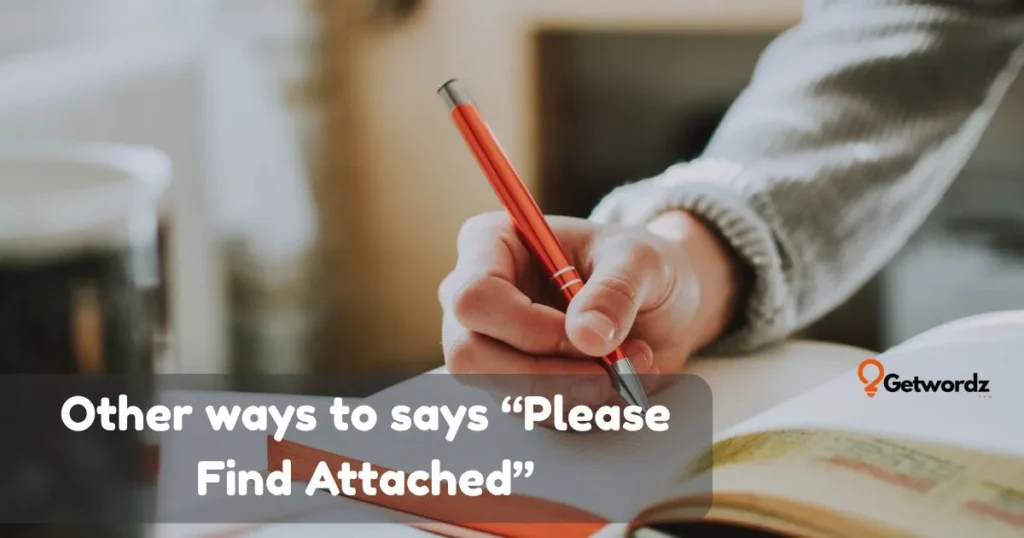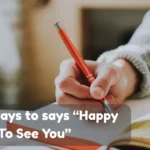Please Find Attached is a common phrase used in emails to indicate that a file or document accompanies the message, but let’s be honest, it’s been used so often that it’s lost its spark.
Whether you’re writing to a client, colleague, teacher, or even a close friend, repeating “please find attached” can sound overly formal or robotic. That’s why so many people search for better, more natural ways to say it, phrases that sound professional yet warm, polished yet personal.
In this post, you’ll discover creative alternatives to please find attached that help you communicate more clearly and authentically. From friendly notes to formal business emails, these unique expressions and better wordings will help your messages feel more human and engaging.
Whether you’re attaching a resume, report, photo, or presentation, you’ll find new ways to express it without sounding repetitive or stiff.
If you’re ready to make your emails sound smarter, friendlier, and more memorable, keep reading, your next favorite alternative to please find attached might be just ahead.
1. Attached for Your Review
Scenario: You’ve just completed a project report and want your manager to look over it before final submission. Instead of the overused “please find attached,” you say “attached for your review” to sound more natural and polished.
Explanation: This phrase is a professional and respectful alternative to please find attached. It sets a clear purpose for the attachment , inviting the recipient to review it. It’s ideal for formal emails and professional communication.
Examples:
- Attached for your review is the finalized project report.
- I’ve included the updated budget sheet attached for your review.
- Attached for your review, you’ll find the client presentation slides.
Why It Works: It’s concise, courteous, and adds context. This expression shows thoughtfulness while keeping your message professional and action-oriented.
2. I’ve Included
Scenario: You’re emailing a friend a travel itinerary you’ve put together for your upcoming trip. Saying “I’ve included” sounds more casual and personal than “please find attached.”
Explanation: This is a simple, conversational way to introduce attachments. It’s a friendly alternative that feels human and works well for both professional and informal settings.
Examples:
- I’ve included the event schedule for next week’s conference.
- I’ve included my resume for your reference.
- I’ve included the design drafts you requested.
Why It Works: It feels natural, approachable, and sincere. It’s an ideal choice when you want your message to sound professional but not overly formal.
3. You’ll Find Attached
Scenario: You’re sending your client a proposal document after a productive meeting. You want to sound polished and confident.
Explanation: This phrase keeps a formal tone but flows more naturally than “please find attached.” It directs the recipient to the attachment clearly and professionally.
Examples:
- You’ll find attached the final version of our agreement.
- You’ll find attached my updated resume and cover letter.
- You’ll find attached photos from our last event.
Why It Works: It’s short, polite, and direct. This wording improves email readability and makes your communication feel more confident and refined.
4. Attached You’ll Find
Scenario: You’re sharing product images with a client after a meeting. This phrasing helps you sound courteous and businesslike.
Explanation: Similar to “you’ll find attached,” this version slightly changes the order for smoother flow. It’s often used in professional correspondence and sounds polished yet warm.
Examples:
- Attached you’ll find the price list for our upcoming catalog.
- Attached you’ll find the signed copy of the agreement.
- Attached you’ll find the photos from yesterday’s shoot.
Why It Works: It feels balanced between formal and friendly. The structure keeps the tone natural and ensures clarity without sounding repetitive.
5. Enclosed Is
Scenario: You’re sending a printed letter with supporting documents or emailing a contract that needs review.
Explanation: “Enclosed is” has a traditional, formal tone, often used in legal, academic, or official documents. It conveys professionalism and precision.
Examples:
- Enclosed is the signed agreement for your records.
- Enclosed is my completed application form.
- Enclosed is the payment confirmation for your reference.
Why It Works: It’s formal and respectful, perfect for business or legal emails. It signals careful attention to detail and a professional demeanor.
6. Here’s the Document
Scenario: You’re chatting casually with a coworker or friend and need to share a quick file.
Explanation: “Here’s the document” is a friendly, conversational alternative. It’s ideal for less formal settings and digital chats.
Examples:
- Here’s the document you asked for earlier.
- Here’s the file with all the design options.
- Here’s the list of vendors we discussed.
Why It Works: It sounds approachable and modern, perfect for day-to-day email or messaging use.
7. Find Attached
Scenario: You’re writing a short professional message and want to keep it concise.
Explanation: “Find attached” keeps a formal tone but drops the extra “please,” making it cleaner and more direct.
Examples:
- Find attached the invoice for this month.
- Find attached the project brief for your approval.
- Find attached the updated marketing plan.
Why It Works: It’s efficient and professional, suitable for people who appreciate concise communication.
8. Attached Herewith
Scenario: You’re drafting a corporate or legal email that demands formality.
Explanation: “Attached herewith” is an old-fashioned but highly formal phrase. It’s used in traditional or legal correspondence where etiquette matters.
Examples:
- Attached herewith is the signed agreement.
- Attached herewith please find the official statement.
- Attached herewith is the completed registration form.
Why It Works: It demonstrates attention to etiquette and formality, ideal for traditional business environments.
9. Please See Attached File
Scenario: You’re emailing a supervisor and want to keep a polite, professional tone.
Explanation: This phrase is straightforward and courteous. It combines clarity with a touch of respect.
Examples:
- Please see attached file for the project details.
- Please see attached file for your review.
- Please see attached file with all the requested data.
Why It Works: It’s direct, respectful, and professional, ideal for maintaining formal communication.
10. I’m Sharing
Scenario: You’re sending vacation photos or design drafts to a friend or client.
Explanation: “I’m sharing” sounds warm and engaging. It’s an inviting way to introduce attachments in emails or messages.
Examples:
- I’m sharing the final logo concepts for your feedback.
- I’m sharing the photos from our weekend trip.
- I’m sharing the updated proposal for your thoughts.
Why It Works: It adds a personal touch while keeping things professional, perfect for friendly yet polished communication.
Read More: Other Ways To Say “Happy To See You” With Examples!
11. The Attached File Contains
Scenario: You’re sending an important data sheet or summary report that needs to be reviewed or approved.
Explanation: “The attached file contains” clearly tells the recipient what’s in the attachment. It’s professional, specific, and helps set expectations.
Examples:
- The attached file contains our sales performance report for Q3.
- The attached file contains the new policy draft for your input.
- The attached file contains all photos from the campaign.
Why It Works: It’s detailed and transparent. This phrase builds trust by letting the reader know exactly what they’re opening.
12. I’ve Attached
Scenario: You’re replying to a client’s email and need to send over requested documents quickly.
Explanation: “I’ve attached” is one of the simplest and most versatile alternatives to please find attached. It’s conversational yet professional.
Examples:
- I’ve attached my updated resume for your review.
- I’ve attached the invoice for this month’s services.
- I’ve attached the presentation slides we discussed.
Why It Works: It’s natural, direct, and polite , perfect for any email style from formal to casual.
13. You Can Find the Attachment Below
Scenario: You’re writing a friendly or semi-formal email with multiple attachments.
Explanation: This phrase gently directs the reader to where the files are located. It’s conversational and helpful.
Examples:
- You can find the attachment below for your quick review.
- You can find the attachment below with all requested materials.
- You can find the attachment below that outlines our next steps.
Why It Works: It adds clarity and makes your message easy to follow, especially when multiple files are attached.
14. The Requested File Is Attached
Scenario: You’re responding to someone who asked for a specific document or file.
Explanation: This alternative to please find attached feels polite and professional. It acknowledges their request while confirming delivery.
Examples:
- The requested file is attached for your convenience.
- The requested file is attached and ready for your review.
- The requested file is attached as per your email.
Why It Works: It feels service-oriented and respectful, showing you’ve fulfilled a specific request.
15. Here Are the Documents
Scenario: You’re sending multiple files to a colleague or client for collaboration.
Explanation: “Here are the documents” is friendly, clear, and suitable for informal or semi-professional exchanges.
Examples:
- Here are the documents you asked for.
- Here are the documents related to our discussion.
- Here are the documents to review before our meeting.
Why It Works: It’s casual yet efficient , perfect when communicating with coworkers or clients you know well.
16. Sent Along Is
Scenario: You’re writing a polite, formal message to an executive or senior contact.
Explanation: “Sent along is” has a gentle, polished tone. It’s a softer version of please find attached and works well in corporate emails.
Examples:
- Sent along is the updated proposal for your feedback.
- Sent along is the finalized project timeline.
- Sent along is the agreement we discussed yesterday.
Why It Works: It feels elegant and respectful while maintaining brevity and clarity.
17. Please Check the Attached File
Scenario: You’re sharing a file that requires action or verification.
Explanation: This phrase is polite yet direct. It’s great when you want the recipient to open and confirm the attachment.
Examples:
- Please check the attached file for any missing details.
- Please check the attached file and let me know if changes are needed.
- Please check the attached file for the updated data.
Why It Works: It encourages engagement and quick response while staying professional.
18. You’ll Find the File Attached
Scenario: You’re sending formal correspondence and want to sound refined.
Explanation: “You’ll find the file attached” is formal, smooth, and easy to read. It’s ideal for professional documents or academic exchanges.
Examples:
- You’ll find the file attached with the requested data.
- You’ll find the file attached containing the updated policy.
- You’ll find the file attached for your quick review.
Why It Works: It’s elegant, trustworthy, and works beautifully in polished, corporate emails.
19. As Requested, I’ve Attached
Scenario: You’re replying to someone’s email where they specifically asked for a file.
Explanation: This phrase adds context by showing you’re fulfilling a prior request. It’s professional and thoughtful.
Examples:
- As requested, I’ve attached the signed agreement.
- As requested, I’ve attached the report summary.
- As requested, I’ve attached the photos from the event.
Why It Works: It’s polite, efficient, and helps maintain a courteous communication loop.
20. Please Refer to the Attached File
Scenario: You’re sending supporting information or backup documentation.
Explanation: This is a more formal, academic-style alternative to please find attached. It directs attention to the attached file for reference.
Examples:
- Please refer to the attached file for complete details.
- Please refer to the attached file for supporting evidence.
- Please refer to the attached file for the finalized version.
Why It Works: It’s formal, precise, and professional, great for corporate, academic, or legal contexts.
21. You’ll Find Everything in the Attachment
Scenario: You’re sending multiple items or a comprehensive document.
Explanation: This phrase is reassuring and helpful, signaling completeness. It’s suitable for both professional and casual use.
Examples:
- You’ll find everything in the attachment, including visuals.
- You’ll find everything in the attachment that you asked for.
- You’ll find everything in the attachment ready to use.
Why It Works: It conveys completeness and organization, making your message sound considerate.
22. Included Below
Scenario: You’re sending a short email where the attachment is directly visible below your message.
Explanation: “Included below” sounds simple and fits modern email formatting. It’s great when embedding visuals or inline content.
Examples:
- Included below are the project visuals.
- Included below is the event checklist.
- Included below are the updated timelines.
Why It Works: It’s clean, current, and efficient , perfect for digital-friendly communication.
23. Attached for Your Convenience
Scenario: You’re sending a file that’s already been shared but want to make it easy for the reader to find again.
Explanation: This polite phrase shows thoughtfulness and professionalism.
Examples:
- Attached for your convenience is the complete proposal.
- Attached for your convenience, you’ll find all required forms.
- Attached for your convenience is a copy of our policy manual.
Why It Works: It’s courteous and considerate, showing attention to your recipient’s ease.
24. I’ve Sent Along
Scenario: You’re emailing your team or partner to share files they’ve been waiting on.
Explanation: “I’ve sent along” sounds friendly and effortless. It fits well in relaxed yet professional conversations.
Examples:
- I’ve sent along the drafts for review.
- I’ve sent along the updated version of the plan.
- I’ve sent along the notes from our last meeting.
Why It Works: It’s warm and human, blending professionalism with approachability.
25. Shared Here Is
Scenario: You’re sending something important but want a modern, friendly tone.
Explanation: This phrase bridges formal and casual communication. It feels dynamic and collaborative.
Examples:
- Shared here is the marketing brief for your approval.
- Shared here is the video file we discussed.
- Shared here is the updated content calendar.
Why It Works: It promotes connection and makes your communication sound inclusive and engaging.
26. For Your Reference, I’ve Attached
Scenario: You’re sending information that doesn’t require immediate action but may be useful later.
Explanation: This is a courteous, informative alternative perfect for documentation sharing.
Examples:
- For your reference, I’ve attached the meeting summary.
- For your reference, I’ve attached our service brochure.
- For your reference, I’ve attached the updated pricing sheet.
Why It Works: It’s calm, professional, and signals value without demanding attention.
27. I’m Sending Over
Scenario: You’re casually emailing a peer or client with an attached document.
Explanation: “I’m sending over” is an informal, friendly phrase that makes communication feel warm and personal.
Examples:
- I’m sending over the files we discussed yesterday.
- I’m sending over the final version of our presentation.
- I’m sending over the report for your quick feedback.
Why It Works: It’s conversational, clear, and modern , perfect for approachable communication.
28. Here Are the Files You Requested
Scenario: Someone specifically asked for multiple files or documents.
Explanation: This alternative acknowledges the request and delivers the solution confidently.
Examples:
- Here are the files you requested for your reference.
- Here are the files you requested last week.
- Here are the files you requested in today’s meeting.
Why It Works: It’s efficient, polite, and acknowledges the recipient’s needs — great for client and team interactions.
29. Attached Below
Scenario: You’re sending files in an email thread or inline format.
Explanation: This phrase is simple, modern, and perfect for digital attachments.
Examples:
- Attached below are the finalized graphics.
- Attached below, you’ll find the invoice and report.
- Attached below are all required documents.
Why It Works: It’s clean, user-friendly, and visually clear , ideal for short, modern email exchanges.
30. Here Is What You Asked For
Scenario: You’re sending a requested file to a coworker, teacher, or friend.
Explanation: This phrase is personal, natural, and versatile , it works across professional and informal contexts.
Examples:
- Here is what you asked for , the project summary.
- Here is what you asked for in yesterday’s meeting.
- Here is what you asked for; let me know if you need anything else.
Why It Works: It feels friendly and genuine while still clear and efficient. It closes communication loops gracefully and naturally.
✅ Pros and cons of Using “Please Find Attached”
pros
- Widely Recognized: It’s a universally understood phrase, making it clear that a file or document is included with your message.
- Professional Tone: It conveys formality and respect, especially useful in corporate or academic communication.
- Concise and Direct: The wording is short and immediately communicates your intent without unnecessary explanation.
- Suitable for Formal Emails: It’s considered appropriate and safe for business, job applications, and official correspondence.
- Works Across Cultures: Since it’s a standard phrase in English emails worldwide, it minimizes confusion in global communication.
⚠️ Cons
- Overused and Robotic: The phrase can sound outdated, stiff, or impersonal after frequent use.
- Lacks Warmth: It doesn’t add any personal or engaging tone to your email, which can make your message feel cold.
- Not Suited for Casual Communication: It feels too formal for friendly or everyday conversations with coworkers or clients.
- Can Feel Passive: It doesn’t actively encourage engagement or response — it simply points to the attachment.
- Misses Personal Connection: With modern communication shifting toward more human, conversational tones, this phrase can feel distant or old-fashioned.
Closing words
Please Find Attached may be one of the most common phrases in professional emails, but using it repeatedly can make your messages sound stiff and predictable. This post explored creative alternatives and fresh wording that help you sound more natural, confident, and engaging. With these unique expressions, you can avoid repetitive language and make every email feel more personal and thoughtful.
Whether you’re writing to colleagues, clients, or friends, these different ways to say please find attached fit every tone, from formal business notes to casual conversations or social media messages. Try one of these creative alternatives in your next email to instantly elevate your communication style.
Using more authentic and varied phrasing shows professionalism, warmth, and attention to detail. So next time you send a file, replace the usual line with a polished, modern twist on please find attached.




